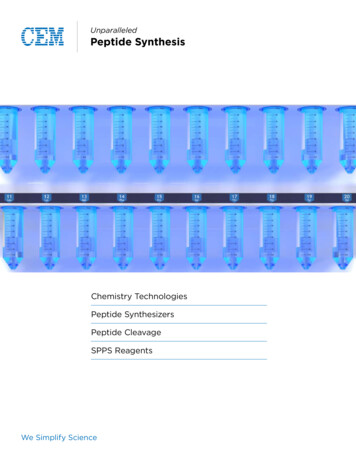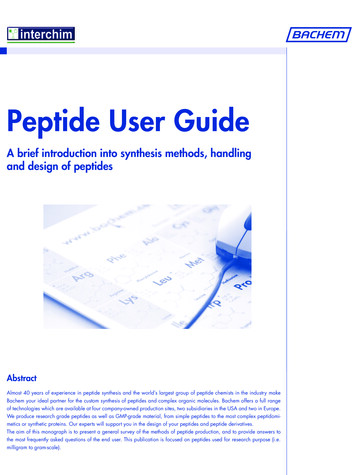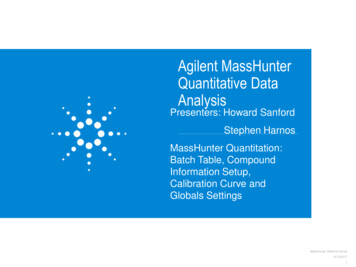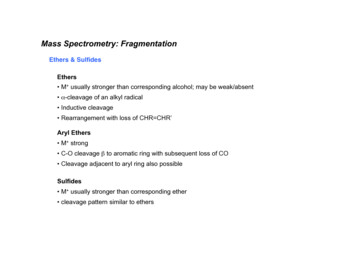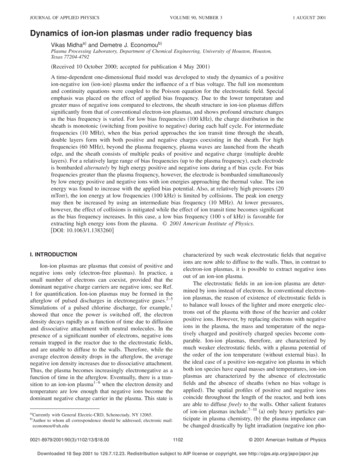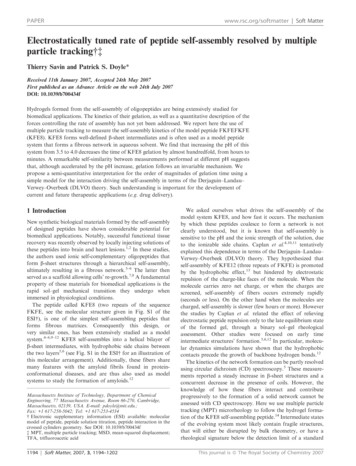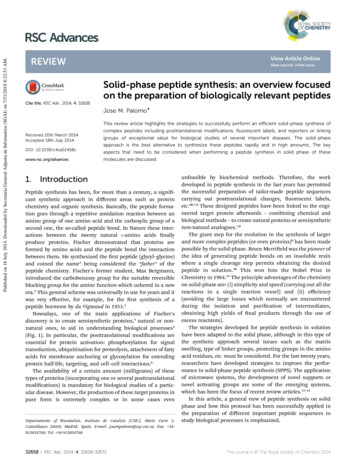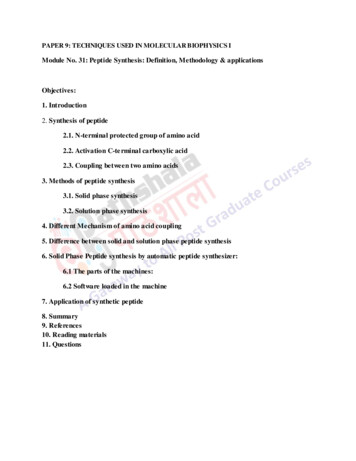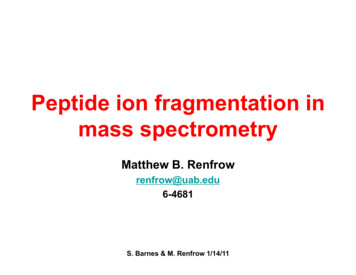
Transcription
Peptide ion fragmentation inmass spectrometrypyMatthew B. Renfrowrenfrow@uab.edu6-4681S. Barnes & M. Renfrow 1/14/11
Where we are so far We’ve discussed the nature of the problem, howwe might attack it and what we believe in MattM tt RRenfrowfhhas ttoldld you– how (remarkably) we get peptide and protein molecularions into gas phase– the importance of isotopes in mass spectrometry– how we measure the m/z values of the ions We also talked about:– how to measure the molecular weight of a protein– How to fragment a protein into smaller pieces to get apeptide mass fingerprint and hence “identify” itS. Barnes & M. Renfrow 1/14/11
Lecture goals Value of fragmentation in determiningstructure How peptides fragment– Interpreting the tandem mass spectrum Automating identification of peptides fromtheir fragment ions– pros and cons Controlling fragmentation– Choice of ionization and fragmentationmethodsS. Barnes & M. Renfrow 1/14/11
Why ion fragmentationprovides useful information Compounds can have the same empiricalformula, i.e., the same molecular weight or m/z,b t bebutb differentdifft chemically.h i ll Breaking them into parts (fragmenting them)h l tohelpst identifyid tif whath t theyth are. Each of the following peptides gives rise to2 ionexactlyl theh same m/z/ forf theh [M 2H][M 2H]2 i– NH2VFAQHLK-COOH– NH2VFQHALK-COOHVFQHALK COOHNH2VAFQHLK-COOHNH2VHLAFQKVHLAFQK-COOHCOOH In proteomics we want to distinguish thesepeptidesS. Barnes & M. Renfrow 1/14/11
What is MSMS-MSMS (tandemmass spectrometry)?gasMolecular ionsAnalyzer 1selected ionAnalyzer 2Collision induced dissociationCollision-inducedS. Barnes & M. Renfrow 1/14/11
Fragmentinggg a peptidep px2y2z2NH3 -CHRCHR1-CO-NH-CHRCO NH CHR2-CO-NH-CHRCO NH CHR3-CO-NH-CHRCO NH CHR4-COOHCOOHR1 OR2 H2N--C--C--N C HH HR1 OR2 H2N--C--C--N--C--C O HH HR2 OR1 O H2N--C--C--N--C--C--NH3 HH Ha2a2b2c2b2c2R4R3 O O C--HN--C--C--N--C--COOH HH Hx2R3 OR4 H3N --C--C--N--C--COOH HH Hy2R3 OR4 C--C--N--C--COOH HH Hz2Adapted from http://www.matrixscience.com/help/fragmentation help.htmlS. Barnes & M. Renfrow 1/14/11
Calculating expected b- and y-ionfragmentsAlanineArginineAsparagineAspartic acidCysteineGlutamic 01114.043115.027103.009129.043128.05857 48186 079186.079163.06399.068bn [residue masses 1] - these come from the N-terminusyn [residue masses H2O 1] these come from the C-terminusb3 ADG,ADG 71.04 115.03 57.02 1 71 04 115 03 57 02 1 244.09244 09ADGTWLEVRy3 EVR, 129.04 99.07 156.10 18 1 403.21S. Barnes & M. Renfrow 1/14/11
Identification of daughter ions andpeptide sequencey101100.61100y9987.52b3Charge state?375.21b2% 147.08y8916.49262.12parent681.45234.13y11y1b4175 12175.12446 3 859.45274.190100200300400500600700800900S. Barnes & M. Renfrow 1/14/11100011001200mass1300
What’sWhats in a peptide MSMSspectrum? In most cases, some, but rarely all, of theththeoreticti bb andd y-ionsiare observedbd Besides b- and y-ions, other types offragmentation can occur to form an and xnions, as well as also losing CO, NH3 andH2O groupsg reactions can occur at Internal cleavageacidic (Asp - Glu) residue sitesS. Barnes & M. Renfrow 1/14/11
upole SWIFTisolatedRenfrow M B et al. J. Biol. Chem. 550Gal16001650GalNAcGalNAc1500m/zIRMPDMS / MSGal15501600m/z1650m/z
Identifying a peptide by denovo sequencing Take the partial sequence that can beidentified manually and submit it toPROWL (http://prowl.rockefeller.edu/) click on PROTEININFO and entersequence - select all species Use suggested sequences to fill in thegaps and then check all theoretical ionsg MS-Product n/msform.cgi?form msproductS. Barnes & M. Renfrow 1/14/11
CID PeptideFragmentation102249362N terminal 461N-terminalb ions 647m/z 746860989The ion’s mass118which would be1233affected by amodified 12798669540425288175Inert Gas(He)C-terminaly ionsm/zS.Eliuk & H. Kim 1/14/2011
Fragmentation by CID(Collision Induced ovo/nomenclature.htmThe most common fragments observed with iontrap triple quadrupoletrap,quadrupole, and QTOF massspectrometersS.Eliuk & H. Kim 1/14/2011
4HNE Michael Adduction of H66*TLDDV I QTGVDNPGHPYb5LTQ-MS/MS**y5 *b8 b13 y10 * y*y79y6y5 y4y3y11 b11 y8 y7**b10b6 b10 b11 b12 b13 b14 b15y8 y4 b5 b8y12 y11 y10 y9y6*b6 b7 b12 b14 *y*12 b15 b7 0 04006 0 06008 0 08001 0 0 010001 2 0 01200m/z10 014001 6 0 016001 8 0 018002 0 0 02000S.Eliuk & H. Kim 1/14/2011
S. Barnes 1/15/10
S. Barnes 1/15/10
Other ions observed in CID peptidefragmentationImmonium and Related L4A5G6E7K8D9N10V11V12Ry ionsy-NH3 ions-----1247.671230.651100.61 987.521083.58 09y-H2O ions---1229.661082.60 969.51898.47841.45712.41584.32------------87.06 120.08N-terminal ionsa-NH3 ions--a ions--b-NH3 ions--b-H2O ions--b ions---88.0487.0672.08S. Barnes & M. Renfrow 1/14/1172.0870.0787.09100.09112.09
Identification of daughter ions andpeptide sequencey101001100.61b ions262 375 446 503 632 760 875 989 1088 1187 1343Ny ionsFLAGEKDNVVR1361 1247 1100 987 916 859 730 602 487 373 274 4.13y11y1b4175 12175.12446 3 859.45274.190100200300400500600700800900S. Barnes & M. Renfrow 1/14/11100011001200mass1300
Issues in MS-MS experiment At any one moment, several peptides maybe co-eluting Data-dependent operation:– The most intense peptide molecular ion isselected first (must exceed an initialthreshold value)– A 2-3 Da window is used (to maximize thesignal)– The ion must be in 2 or 3 state– Since the ion trap scan of the fragmentions takes 1 sec, only the most intenseiionswillill beb measuredd– However, can use an exclusion list on asubsequent run to study minor ionsS. Barnes & M. Renfrow 1/14/11threshold
VLCLNeuAcα2,323VHC 1C C C C C 1Galβ1 3β1,3GalNAcNeuAcα2 VK HYTNPSQDVTVPCPVPSTPPTPSPSTPPTPSPSCCHPRL ro-Ser-Cys225228230232236CH2
ESI FT-ICR positive ion mass spectra of isolated IgA1 HR peptide.R fRenfrowM B ett al.l JJ. BiBiol.l ChChem. 20052005;280:19136-19145280 19136 19145 2005 by American Society for Biochemistry and Molecular Biology
IgA1 hinge region O-glycosylationneuraminidase O-glycanase treatedGalNacde-glycosylateddeglycosylated HR alNacneuraminidase treatedGalGal1000110012001300 140015001600
IgA1 hinge region O-glycosylationVTVPCPVPSTPPTPSPSTPPTPSPSCCHPRL[M 3H]3 IRMPDy273 x5y293 y132 / b7 x5y17y102 y3b3b5300500y16y242 y262 2 2 y142 700y282 y212 2y222 y272 [M 2H]2 y292 900110013001500 m/z
Let’s take a closer look atfragmentationb3 ion - oxazaloneno b1 ionS. Barnes & M. Renfrow 1/14/11Wysocki et al. 2005
Other amino acid fragment ionsS. Barnes & M. Renfrow 1/14/11Wysocki et al. 2005
Detecting posttranslationalmodifications (PTMs) by MS A key issue is that the energy of ionization or the collisionalprocess should not exceed the dissociational energygy of thePTM MALDI-TOFMALDI TOF MS with a N2 laser causes fragmentation of anitrated tyrosine residue– Use ESI to make the molecular ion– Go to another laser wavelength (YAG laser at 355 nm or IR) O-glucosyl and phospho groups fragment more easily thanthe peptide to which they are attached– Use electron capture dissociationS. Barnes & M. Renfrow 1/14/11
IgA1 hinge region O-glycosylationVTVPCPVPSTPPTPSPSTPPTPSPSCCHPRL GalNAc-Gal m/z
Types of fragmentation (1) Collision-induced dissociation (CID)– Also called CAD (collision-activated dissociation)– Multiplyp y chargedg peptidep pions are isolated byy an m/zbased filter– Selected ions are accelerated into a field of inert gas(He N2, Ar,(He,Ar Xe) at moderate pressure– The energy gained in collision events increasesvibrational and stretching modes of the peptidebackbone (and anything attached to it!)– The increased motion of the energized peptide causesbreaks that occur typically at the peptide bond Side chain groups can also be broken, some times moreeasily than the peptide chainS. Barnes & M. Renfrow 1/14/11
Fragmentationgof nitrated peptidesp pin MALDI-TOF experimentS. Barnes & M. Renfrow 1/14/11
ESI-tandem MS of a nitrated peptideS. Barnes & M. Renfrow 1/14/11
1/15/10aa658-668 RNSILTETLHR Unmodified m/z 447.37(3S. )Barnes1339.09Da448.7b-ions358 471 584 685 814 915----RNSI--------LTET------LHR869 756 655 526 425312 175 y-ions471.3(b4)526.6(y4)584.6(b5)425.5(y3)685 0667.6637.6509.5550869.6(y7)814.6(b7)600 650m/z, amu915.6(b8)738.6700750S. Barnes 1/15/10800850900950 1000 1050 1100 1150
aa658-668 RNsILTETLHR Phosphorylated m/z 474.00(3 )453.4(b4-98)1419.00 Daltons474.2 (parent)b-ions340 453 566--271RNsIL----------340.3(b3-98)------TET756 655 526----LH--R425 312 175 57.1155.2170.3213.1263.7294.2100150200250300379.2 426.5441.7468.0350400450500550m/z, amu637.6649.4600S. Barnes 1/15/10650747.5738.6700750800850900950
Types of fragmentation (2)IRMPD InfraRed Multi-Photon Dissociation–UUsedd iin FT-ICRFT ICR iinstrumentstt whereha vacuumbetter than 1 x 10-10 torr is necessary for theanalysisyof ppeptidepions– The infra-red radiation is delivered by an IRlaser operating at 10.6 microns– No gas is involved– In this case, the fragmentation is induced inthe ICR cell– Effects are essentially equivalent to CIDS. Barnes & M. Renfrow 1/14/11
ECD and IRMPD with the Finnigan LTQ FTFTICR MS Electron Capture Dissociation(ECD) Infra-Red Multiphoton Dissociation(IRMPD)Linear Ion Trap MS MS, MS/MS and MSn Analysis byCollision Induced DissociaitonLinear Ion TrapFTMS7 T Actively ShieldedSuperconducting MagnetECD AssemblyIRMPD Laser Assembly34
adrupole l1650GalNAcGalNAc15001600IRMPDMS / MSGal15501600m/z1650m/z
Types of fragmentation (3)ECD Electron Capture Dissociation– Used in an ICR cell of an FTFT-MSMS instrument– Low energy electrons interact with the multiplycharged peptide and are absorbed– They disturb bonding of the peptide backboneand cleave it without altering the side chain– Yields cc and z-ionsz ions– MS-MS spectra often very clean, but lowsensitivity– In conjunction with an IR laser, ECD canfragment whole proteins (top-down)S. Barnes & M. Renfrow 1/14/11
N E D E G pS S S E A D E M A K A L E A E L N D L M[M HPO3 3H]3 80 Da x 10[M HPO3 3H]2 &[[M HPO3 2H]]2 x2c11c22c222 2c4c5z13 ECD10 msc13z14 c8c6 c72 c14c9c10c16c15 z17 c18c18400 600 800 1000 1200 1400 1600 1800 2000 2200z22 m/z
Sequencing O-GlcNAc peptides by ECD FT-ICR-MSCasein kinase II - AGGSTPVSSANMMSG[Abs. Int. * 1000000]cVS1.5SANM[M 2H]2 1.41.31.2c8 fragment with sugar 3.443221061.51275 1175.55852 1306.59534c8c 12c 10c 0900R1 OH3 NCHb ionicleavagelCm/z10001100R2 ONHCHC120013001400R3NHCHCOOHc ionicleavagelS. Barnes & M. Renfrow 1/14/11
CID spectra of Arg-rich peptideFurry spectraFt duedto -NH3 losses fromArg residuesSpectra areuninterpretableS. Barnes 1/15/10S. Barnes & M. Renfrow 1/14/11
ECD spectrapof cystinypeptidep pS. Barnes & M. Renfrow 1/14/11
ECD spectra of phosphorylatedcystinti peptidetidS. Barnes & M. Renfrow 1/14/11
IRMPD FragmentationFt ti patterntt GlcNAc Fuc ManM XylS K PAQ GYGYLG I F N N S KK. Håkansson, H. J. Cooper, M. R. Emmett, C. E. Costello, A. G. Marshall,C. L. Nilsson, Anal. Chem. 73, 4530 (2001).
ECD Fragmentation Pattern GlcNAc Fuc Man Xyl2 2 c15 c16c4 c5 c6 c7 c8 c9 c10S K PAQ GYGYLG I F N N S Kz162 ·z3K. Håkansson, H. J. Cooper, M. R. Emmett, C. E. Costello, A. G. Marshall,C. L. Nilsson, Anal. Chem. 73, 4530 (2001).
Types of fragmentation (4)ETD Electron Transfer Dissociation– The electron is provided by an electrondonating chemical species, a radical anion(azobenzene fluoranthene) directly infused as(azobenzene,a reagent gas, or from their precursorsintroduced by ESI - 99-anthracenecarboxylicanthracenecarboxylicacid, 2-fluoro-5-iodobenzoic acid, and 2(fluoranthene-8-carbonyl)benzoic acid)S. Barnes & M. Renfrow 1/14/11
Electron transfer dissociationS. Barnes & M. Renfrow 1/14/11
S. Barnes 1/15/10
Syka et al.,Syka,al PNAS 2004
CAD versus ETD for phosphopeptidePhosphopeptide losesphosphate but no sequencephosphate,information is obtainedRich series of c and z ionsS. Barnes & M. Renfrow 1/14/11
ETD better for sulfonated peptidesETDS. Barnes & M. Renfrow 1/14/11
Takahashi et al., MCP, 2010
Takahashi et al., MCP, 2010
What affects fragmentation?gChemical compositionpPeptidesAmino Acid SequenceAdjacent Amino AcidsCharge StateLocation of ChargeSizeMechanism of FragmentationgDouble BondsElectrophilesP t MobilityProtonM bilitGas phase chemistryS. Barnes 1/15/10
What can yyou do with afragment besides identify? Localize PTMs Use it to establish signatures for specific ion species Biomarker Use it to quantify Use it to convict a felon Add a fragment to create an isobaric tag for quantitativecomparison. UseUse it to filter out the information (spectra) you want
Tandem mass spectrometry on atriplep qquadrupolepinstrumentN2GasSamplesolutionCollision gas-- - --5 KV--Q1 Daughter ion spectra Parent ion spectra Multiple reaction ionscanningS. Barnes & M. Renfrow 1/14/11Q2Q3Detector
N-glycan on aminopeptidase 1Stephens et al., Eur J. Biochem, 2004
fragmentation pattern of dephosphorylatedlipid A derived from LPS1 (LA1Moran et al., JBC 2002
Other amino acid fragment ionsS. Barnes & M. Renfrow 1/14/11Wysocki et al. 2005
Lecture goalsLecture goals Value of fragmentation in determiningValue of fragmentation in determining structure How peptides fragmentHow peptides fragment - Interpreting the tandem mass spectrum Automating identification of peptides fromAutomating identification of peptides from their fragment ions - pros and conspros and cons Controlling fragmentation
